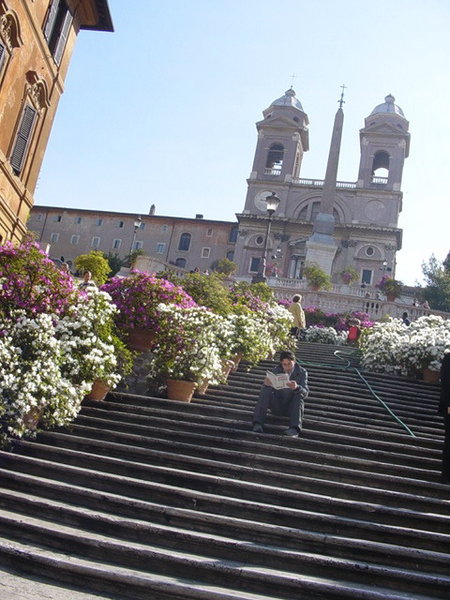| Spanish Steps | ||
|
ROME SIGHTS
Colosseum Roman Forum Sistine Chapel Trevi Fountain St Peters Square Basilica Vatican Museums Pantheon Piazza Navona Spanish Steps
ODD ROME
VISIT THE WORLD FAMOUS...
EuroBlog!!!!! |
 Spanish Steps
Distance from hotel:
THE HISTORY The Spanish Steps (Scalinata di Spagna) in Rome ramp a steep slope between the Piazza di Spagna at the base and the church Trinitą dei Monti above. The monumental stairway, of 138 steps, was built with French diplomat Stefano Gueffiers funds (20.000 "scudi") in 1723‑1725, linking the Bourbon Spanish embassy to the Holy See, today still located in the piazza below, with the Trinitą dei Monti church above.The Spanish Steps were designed by Francesco De Sanctis after generations of heated discussion over how the steep slope to the church on a shoulder of the Pincio should be urbanized. The solution is a gigantic inflation of some conventions of terraced garden stairs. During Christmas time an impressive 19th century crib is assembled in the first terrace of the staircase. During May, half of the monument is covered by flowerpots full of azalea plants. Although some impolite tourists consider the Spanish steps a favourite place for eating lunch or playing music, such behaviour is strictly forbidden and heavily fined. The apartment that was the setting for The Roman Spring of Mrs Stone (1961) is halfway up on the right. The Spanish Steps have been restored several times, most recently in 1995. In the Piazza at the base is the Early Baroque fountain called the Barcaccia ('the ugly boat'), often credited to Pietro Bernini, father of a more famous son. In the Piazza, at the corner on your right as you begin to climb the steps, is the house where English poet John Keats lived and died in 1821; it is now a museum dedicated to his memory, full of memorabilia of the English Romantic generation. On the same right side you can see the 15th century former cardinal Cybos palace, now Ferrari di Valbona, building altered in the 1936 by famous architect Marcello Piacentini, the main town planner during Fascism, with impressive unique modern terraces perfectly in harmony with the surrounding baroque contest. At the top the Viale ramps up the Pincio which is the Pincian Hill, omitted, like the Janiculum, from the classic Seven hills of Rome Though the faēade of the church of Trinitą dei Monti just misses becoming an architecturally cohesive unity, its twin towers dominate the ensemble. In 1494 St Francis di Paola, a Calabrian hermit, bought a vineyard from cardinal Ermolao Barbaro, former patriarch of Acquileia, and then obtained the authorization to establish a monastery from pope Alexander VI. In 1502 Louis XII began the Trinitą dei Monti church next to this monastery. The church was consecrated in 1585 by the great urbanizing Pope Sixtus V, whose via Sistina connects the Piazza below with the Piazza del Popolo. From 1828 these Italian properties are entrusted to the Order of the Dames du Sacre Coer, a French religious order, due to an agreement between pope Leone XII and Carlo X, king of France.
|